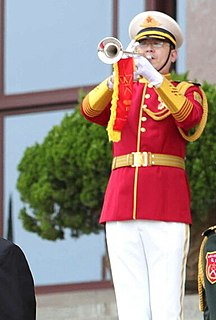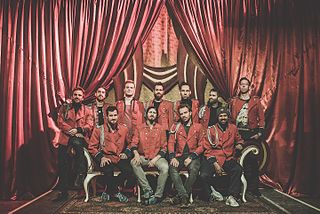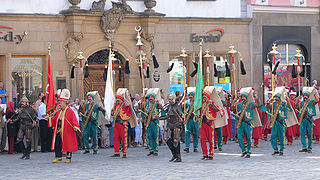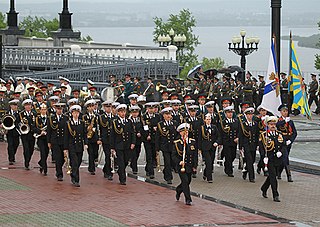 W
WA marching band is a group of instrumental musicians who perform while marching, often for entertainment or competition. Instrumentation typically includes brass, woodwind, and percussion instruments. Most marching bands wear a uniform, often of a military-style, that includes an associated organization's colors, name or symbol. Most high school marching bands, and some college marching bands, are accompanied by a color guard, a group of performers who add a visual interpretation to the music through the use of props, most often flags, rifles, and sabres.
 W
WThe Artane Band is a marching band for young musicians based at the Artane School of Music in Artane in Dublin, Ireland.
 W
WBrønnøysund Musikkorps (BMK) is a wind band in Brønnøysund, Norway, with approx. 50 members. The BMK slogan is Korps for folk.
 W
WThe chair step is a type of high step used by marching bands. This step is named because of the resemblance of the leg in action to a leg's position when sitting in a chair. It is primarily used by bands that brand themselves as traditional-style bands. Nearly all bands in the Big Ten Conference use this style. It is also common in Midwestern high school marching bands, most of which are heavily influenced by Big Ten bands.
 W
WColor guards or flag corps are teams of performers who perform choreographed dances and routines with various equipment to enhance and interpret the music of the marching band show. Color guard teams can be found in American colleges, universities, high schools, middle schools and independent drum corps. They use various equipment including, flags, non-functioning rifles, and sabres, along with other props. Most Color Guard groups are of mixed gender but some may also be single gender.
 W
WThe Philharmonic Society of Corfu, or Old Philharmonic -to be distinguished from the others on the island-, is a widely known community music band in Corfu, Greece.
 W
WA Corps of Drums, also sometimes known as a Fife and Drum Corps, Fifes and Drums or simply Drums is a unit of several national armies. Drummers were originally established in European armies to act as signallers. The major historical distinction between a military band and a corps of drums, was that 'drummers' were not employed to play their instruments to entertain or delight, but rather they carried out a utilitarian battlefield role. This role was fulfilled by trumpeters or buglers in the cavalry and the artillery, who did not form into comparative formed bodies in the way that drummers did; therefore, an orthodox corps of drums will exist in the infantry arm.
 W
WA Corps style band is a type of marching band based on those of Drum Corps International. Notable differences include the introduction of the roll step, backwards marching and sliding, and the "8 to 5" step size.
 W
WA dot book is a small notebook utilized by marching bands in order to aid the learning of formations on a field. The dot book was invented by Leslie Allard, a prominent high school band instructor and all-star percussionist. The name is derived from the use of dots on drill sheets which symbolize players on the field: a dot book focuses on the owner's particular dots and other marchers the player may have to guide.
 W
WA drum major or field commander is the leader of a marching band, drum and bugle corps, or pipe band, usually positioned at the head of the band or corps. The drum major is often dressed in more ornate clothing than the rest of the band or corps and is responsible for providing commands to the ensemble, leading them while marching, and directing them what to play, when to play, and what time to keep. The commands may be given verbally, through hand gestures, using a whistle or a baton, or with a mace. Although the drum major is the one conducting for the entire band to see and watch to keep time, the drum major is actually looking at the center snare's feet to keep time. The center snare is the leader of the Drumline, and is the one who keeps the band in time while marching. He/she usually plays taps and/or some rolls to set the tempo of how fast the band marches.
 W
WA fanfare band, fanfare corps, fanfare battery, fanfare team, horn and drum corps, bugle band, drum and bugle corps, or trumpet and drum band is a military or civilian musical ensemble composed of percussion instruments, bugles, natural horns and natural trumpets. Fanfare bands are the descendants of the old medieval trumpet and drum teams that sounded fanfares on important occasions and are related to drum and bugle corps internationally.
 W
WThe French Foreign Legion Music Band or Foreign Legion Music, formerly officially designated as the Principal Music of the Foreign Legion is a Musical Formation of the French Army composed largely of Legionnaires of the French Foreign Legion.
 W
WThe French Republican Guard Band is a military band unit of the French Republican Guard. The band is composed of 120 professional musicians from senior national conservatories. It is a part of the National Gendarmerie. As the senior band and field music unit of the French Armed Forces, it is aimed towards active participation as the musical accompaniment in all national events.
 W
WIn a marching band or a drum and bugle corps, the front ensemble or pit is the stationary percussion ensemble. This ensemble is typically placed in front of the football field, though some groups will work the front ensemble into a tight pod onto the marching field. Some high school marching bands opt not to march any percussion instruments, but instead have a "full" front ensemble.
 W
WGuggenmusik is a term widely used in the Alemannic region of Switzerland, Austria and southern Germany to designate both a Carnival marching band and the type of music it plays.
 W
WThis is a list of marching bands. Major types include collegiate and military. At least 16 U.S. colleges have had scramble bands, which are also included in this list.
 W
WMajor Minor's Majestic March is a music video game for the Wii. It was created by Parappa the Rapper designer Masaya Matsuura and artist Rodney Greenblat.
 W
WA majorette is a baton twirler whose twirling performance is often accompanied by dance, movement, or gymnastics; they are primarily associated with marching bands during parades. Majorettes can also spin knives, fire knives, flags, light-up batons, fire batons, maces and rifles. They do illusions, cartwheels, and flips, and sometimes twirl up to four batons at a time. Majorettes are often confused with cheerleaders; baton twirling, however, is more closely related to rhythmic gymnastics than to cheerleading.
 W
WThe Marching and Cycling Band HHK was a marching band from Haarlem, The Netherlands which existed from 1964 until 2014, started by a fusion in 1964 of two ancestor bands: Kunstkring Apollo and Harmonie Crescendo under the name of Haarlems Harmonie Kapel (HHK). The band had a unique way of performing: marching and cycling, hence the name "Marching and Cycling Band HHK".
 W
WMeute is an eleven-piece self-described techno marching band from Germany. The band arranges Techno, House and Deep House works by well-known DJs, augmenting them with electronic beats created by marching band instruments. In doing so, they seek to "[create] a new genre by combining hypnotic driving techno and expressive brass band music," thereby "detaching electronic music from the DJ desk." Meute have toured Europe, America, and southern Africa in their four-year history and have performed in a variety of venues, including city streets, music festivals, and classical concert halls.
 W
WA military band is a group of personnel that performs musical duties for military functions, usually for the armed forces. A typical military band consists mostly of wind and percussion instruments. The conductor of a band commonly bears the title of Bandmaster or Director of Music. Ottoman military bands are thought to be the oldest variety of military marching bands in the world, dating from the 13th century.
 W
WOttoman military bands are thought to be the oldest variety of military marching bands in the world. Though they are often known by the word Mehter in West Europe, that word, properly speaking, refers only to a single musician in the band. In Ottoman, the band was generally known as mehterân, though those bands used in the retinue of a vizier or prince were generally known as mehterhane, the band as a whole is often termed mehter bölüğü, mehter takımı. In West Europe, the band's music is also often called Janissary music because the janissaries formed the core of the bands.
 W
WThe George N. Parks Drum Major Academy is a nationwide summer academy for high school drum majors and majorettes. It was founded in 1978 by George N. Parks.
 W
WThe Presidential Band of the Presidential Security Forces of the Republic of Indonesia, also known commonly in public as the Paspampres Presidential Band, is the foremost military band of the Indonesian National Armed Forces which serves as the military band service of the President of Indonesia, the Vice President of Indonesia, and their families. As part of the Paspampres, it is affiliated to and leads all military bands within the INAF as the country's seniormost military band.
 W
WFor the Tournament of Roses Parade, top marching bands from all over the world are invited. Many of the nation's top high school marching bands participate, along with college and organizational marching bands.
 W
WRussian military bands fall under the jurisdiction of the Military Band Service of the Armed Forces of Russia, which is the official music service for the Russian Armed Forces, and led by the Senior Director of Music, a billet of an officer with the rank of a Colonel or a general officer. There are currently between 200 and 300 military bands in the Russian Armed Forces that span across the military as well as all uniformed services in the country. Unlike most western nations, the Armed Forces does not maintain any bands composed of volunteering civilian musicians, as all bands, active or reserve, are manned by graduates of the military music training centers stationed anywhere in the country, as well as of civilian conservatories. While choirs may be attached to military bands, individual staff choirs do not exist in the Russian Armed Forces, since they have attached instrumental ensembles or orchestras. As of 2009, all military musicians are paid around 13,000 rubles ($169.65) for their service in the Armed Forces.
 W
WA school band is a group of student musicians who rehearse and perform instrumental music together. A concert band is usually under the direction of one or more conductors. A school band consists of woodwind instruments, brass instruments and percussion instruments, although upper level bands may also have string basses or bass guitar.